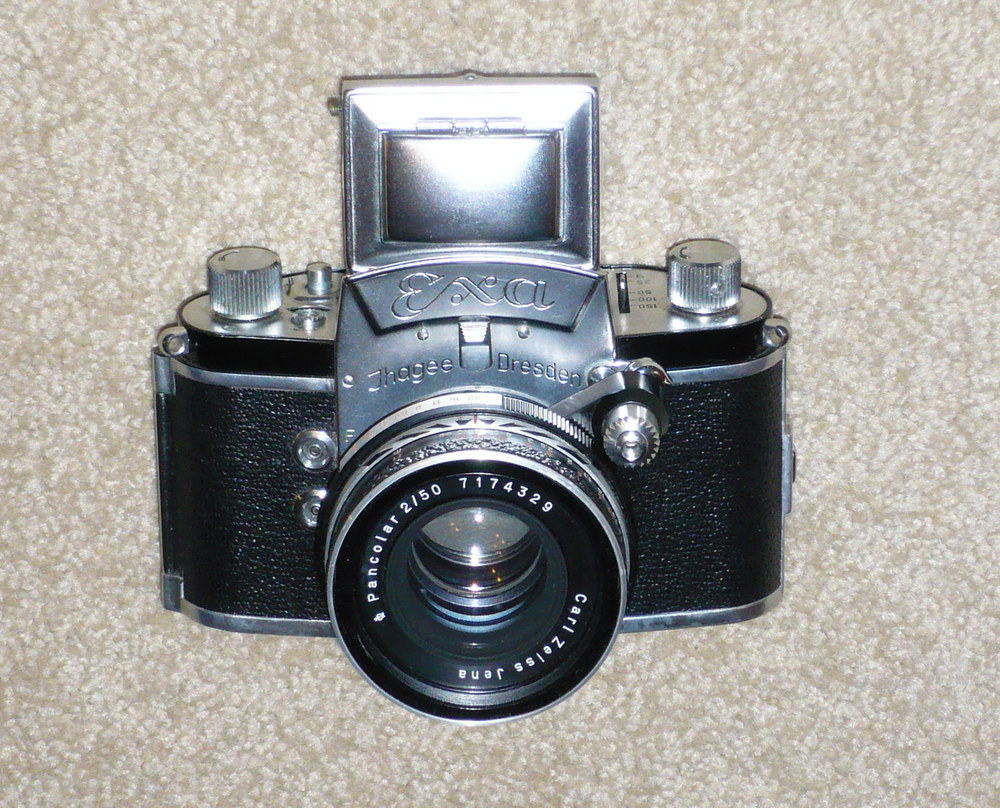|
Relay Lens
In optics, a relay lens is a lens or a group of lenses that receives the image from the objective lens and relays it to the eyepiece. Relay lenses are found in refracting telescopes, endoscopes, and periscopes to optically manipulate the light path, extend the length of the whole optical system, and usually serve the purpose of inverting the image. They may be made of one or more conventional lenses or achromatic doublets, or a long cylindrical gradient-index of refraction lens (a GRIN lens). Relay lenses operate by producing intermediate planes of focus. For example, in a SLR camera the zoom lens produces an image plane where the image sensor or photographic film would usually go. If you place another lens with focal length ''f'' at the distance 2''f'' from that image plane and then put an image sensor at 2''f'' beyond that lens, that lens will relay the first image to the second image with 1:1 magnification (see thin lens formula showing that with object distance s=2f f ... [...More Info...] [...Related Items...] OR: [Wikipedia] [Google] [Baidu] |
Single-lens Reflex Camera
In photography, a single-lens reflex camera (SLR) is a type of camera that uses a mirror and prism system to allow photographers to view through the lens and see exactly what will be captured. SLRs became the dominant design for professional and consumer-level cameras throughout the late 20th century, offering interchangeable lenses, through-the-lens (TTL) metering, and precise framing. Originating in the 1930s and popularized in the 1960s and 70s, SLR technology played a crucial role in the evolution of modern photography. Although digital single-lens reflex (DSLR) cameras succeeded film-based models, the rise of Mirrorless camera, mirrorless cameras in the 2010s has led to a decline in SLR use and production. With twin lens reflex and rangefinder cameras, the viewed image could be significantly different from the final image. When the shutter button is pressed on most SLRs, the mirror flips out of the light path and allows light to pass through to the light receptor and the im ... [...More Info...] [...Related Items...] OR: [Wikipedia] [Google] [Baidu] |
Roof Prism
A roof prism, also called a Dachkanten prism or Dach prism (from German: ''Dachkante'', lit. "roof edge"), is a reflective prism containing a section where two faces meet at a 90° angle, resembling the roof of a building and thus the name. Reflection from the two 90° faces returns an image that is flipped laterally across the axis where the faces meet. Characteristic for a roof prism is that the beam is split in half, with one half of the beam hitting first one face then the other face, while it is invert for the other half of the beam. Therefore, a roof prism can be used only with some distance to focal planes, or the "edge" of the roof would introduce slight distortions. Furthermore, the angle between the two faces has to be very close to 90°, or image quality would be degraded. The simplest roof prism is the Amici roof prism, with other common roof prism designs being the Abbe–Koenig prism, the Schmidt–Pechan prism and probably the best known being the roof pentap ... [...More Info...] [...Related Items...] OR: [Wikipedia] [Google] [Baidu] |
Porro Prism
In optics, a Porro prism, named for its inventor Ignazio Porro, is a type of ''reflection prism'' used in optical instruments to alter the orientation of an image. Description It consists of a block of material shaped like a right geometric prism with right-angled triangular end faces. In operation, light enters the large rectangular face of the prism, undergoes total internal reflection twice from the sloped faces, and exits again through the large rectangular face. When the light enters and therefore exits the glass at normal incidence, the prism is not dispersive. An image travelling through a Porro prism is rotated by 180° and exits in the opposite direction offset from its entry point. While a single Porro prism can be constructed to work as well as a roof prism, it is seldom used as such. Therefore, to reduce the cost of production for a Porro prism, the edge of the roof is usually left out. Sometimes only one small window as an entrance surface and one window as e ... [...More Info...] [...Related Items...] OR: [Wikipedia] [Google] [Baidu] |
Prism (optics)
An optical prism is a transparent optical element with flat, polished surfaces that are designed to refract light. At least one surface must be angled—elements with two parallel surfaces are ''not'' prisms. The most familiar type of optical prism is the triangular prism, which has a triangular base and rectangular sides. Not all optical prisms are geometric prisms, and not all geometric prisms would count as an optical prism. Prisms can be made from any material that is transparent to the wavelengths for which they are designed. Typical materials include glass, acrylic and fluorite. A dispersive prism can be used to break white light up into its constituent spectral colors (the colors of the rainbow) to form a spectrum as described in the following section. Other types of prisms noted below can be used to reflect light, or to split light into components with different polarizations. Types Dispersive ''Dispersive prisms'' are used to break up light into its ... [...More Info...] [...Related Items...] OR: [Wikipedia] [Google] [Baidu] |
Karl Storz GmbH
Karl Storz SE & Co. KG is an internationally operating family-owned company headquartered in Tuttlingen, Baden-Württemberg. The company was founded in 1945 and specialises in the production and distribution of medical instruments and devices. It is recognised as a global leader in human medical instruments in the field of minimally invasive surgery and rigid endoscopes used for examining body cavities. After the death of founder Karl Storz in 1996, his daughter, Sybill Storz, took over the company’s management. At the beginning of 2019, leadership transitioned to her son, Karl-Christian Storz. History Foundation and beginnings Karl Storz, a surgical mechanic, founded his company in 1945 in Tuttlingen, initially focusing on the production of instruments and lamps for ear, nose, and throat medicine. In the early 1950s, Karl Storz developed and produced the first endoscopes with a traditional lens system, marking the company's entry into endoscopy. In 1956, he also invente ... [...More Info...] [...Related Items...] OR: [Wikipedia] [Google] [Baidu] |
Index Of Refraction
In optics, the refractive index (or refraction index) of an optical medium is the ratio of the apparent speed of light in the air or vacuum to the speed in the medium. The refractive index determines how much the path of light is bent, or refracted, when entering a material. This is described by Snell's law of refraction, , where and are the angle of incidence and angle of refraction, respectively, of a ray crossing the interface between two media with refractive indices and . The refractive indices also determine the amount of light that is reflected when reaching the interface, as well as the critical angle for total internal reflection, their intensity (Fresnel equations) and Brewster's angle. The refractive index, n, can be seen as the factor by which the speed and the wavelength of the radiation are reduced with respect to their vacuum values: the speed of light in a medium is , and similarly the wavelength in that medium is , where is the wavelength of that light in v ... [...More Info...] [...Related Items...] OR: [Wikipedia] [Google] [Baidu] |
Numerical Aperture
In optics, the numerical aperture (NA) of an optical system is a dimensionless number that characterizes the range of angles over which the system can accept or emit light. By incorporating index of refraction in its definition, has the property that it is constant for a beam as it goes from one material to another, provided there is no refractive power at the interface (e.g., a flat interface). The exact definition of the term varies slightly between different areas of optics. Numerical aperture is commonly used in microscopy to describe the acceptance cone of an Objective (optics), objective (and hence its light-gathering ability and Optical resolution, resolution), and in fiber optics, in which it describes the range of angles within which light that is incident on the fiber will be transmitted along it. General optics In most areas of optics, and especially in microscopy, the numerical aperture of an optical system such as an objective lens is defined by \mathrm = n \sin \t ... [...More Info...] [...Related Items...] OR: [Wikipedia] [Google] [Baidu] |
Erect Image
In optics, an erect image is one that appears right-side up. An image is formed when rays from a point on the original object meet again after passing through an optical system. In an erect image, directions are the same as those in the object, in contrast to an inverted image. It is one of the properties of images formed in a plane mirror. Some telescopes and other devices such as the camera obscura present an inverted image on the viewing surface. Mirrors and compound prism elements can be used to achieve an erect image instead. See also *Real image *Virtual image *Mirror image A mirror image (in a plane mirror) is a reflection (physics), reflected duplication of an object that appears almost identical, but is reversed in the direction perpendicular to the mirror surface. As an optical phenomenon, optical effect, it r ... Optics {{optics-stub ... [...More Info...] [...Related Items...] OR: [Wikipedia] [Google] [Baidu] |
Telescopic Sight
A telescopic sight, commonly called a scope informally, is an optical sighting device based on a refracting telescope. It is equipped with some form of a referencing pattern – known as a ''reticle'' – mounted in a focally appropriate position in its optical system to provide an accurate point of aim. Telescopic sights are used with all types of systems that require magnification in addition to reliable visual aiming, as opposed to non-magnifying iron sights, reflector (reflex) sights, holographic sights or laser sights, and are most commonly found on long-barrel firearms, particularly rifles, usually via a scope mount. Similar devices are also found on other platforms such as artillery, tanks and even aircraft. The optical components may be combined with optoelectronics to add night vision or smart device features. History The first experiments directed to give shooters optical aiming aids go back to the early 17th century. For centuries, different optical ... [...More Info...] [...Related Items...] OR: [Wikipedia] [Google] [Baidu] |
Optical Telescope
An optical telescope gathers and focus (optics), focuses light mainly from the visible spectrum, visible part of the electromagnetic spectrum, to create a magnification, magnified image for direct visual inspection, to make a photograph, or to collect data through electronic image sensors. There are three primary types of optical telescope : * ''Refracting telescopes'', which use lens (optics), lenses and less commonly also Prism (optics), prisms (dioptrics) * ''Reflecting telescopes'', which use mirrors (catoptrics) * ''Catadioptric system#Catadioptric telescopes, Catadioptric telescopes'', which combine lenses and mirrors An optical telescope's ability to resolve small details is directly related to the diameter (or aperture) of its objective (optics), objective (the primary lens or mirror that collects and focuses the light), and its light-gathering power is related to the area of the objective. The larger the objective, the more light the telescope collects and the finer det ... [...More Info...] [...Related Items...] OR: [Wikipedia] [Google] [Baidu] |
Thin Lens
In optics, a thin lens is a lens (optics), lens with a thickness (distance along the optical axis between the two surfaces of the lens) that is negligible compared to the radius of curvature (optics), radii of curvature of the lens surfaces. Lenses whose thickness is not negligible are sometimes called ''thick lenses''. The thin lens approximation ignores optical effects due to the thickness of lenses and simplifies Ray tracing (physics), ray tracing calculations. It is often combined with the paraxial approximation in techniques such as ray transfer matrix analysis. Focal length The focal length, ''f'', of a lens in air is given by the lensmaker's equation: :\frac = (n-1) \left[ \frac - \frac + \frac \right], where ''n'' is the index of refraction of the lens material, ''R''1 and ''R''2 are the Radius of curvature (optics), radii of curvature of the two surfaces, and ''d'' is the thickness of the lens. Here ''R''1 is taken to be positive if the first surface is convex, and nega ... [...More Info...] [...Related Items...] OR: [Wikipedia] [Google] [Baidu] |






